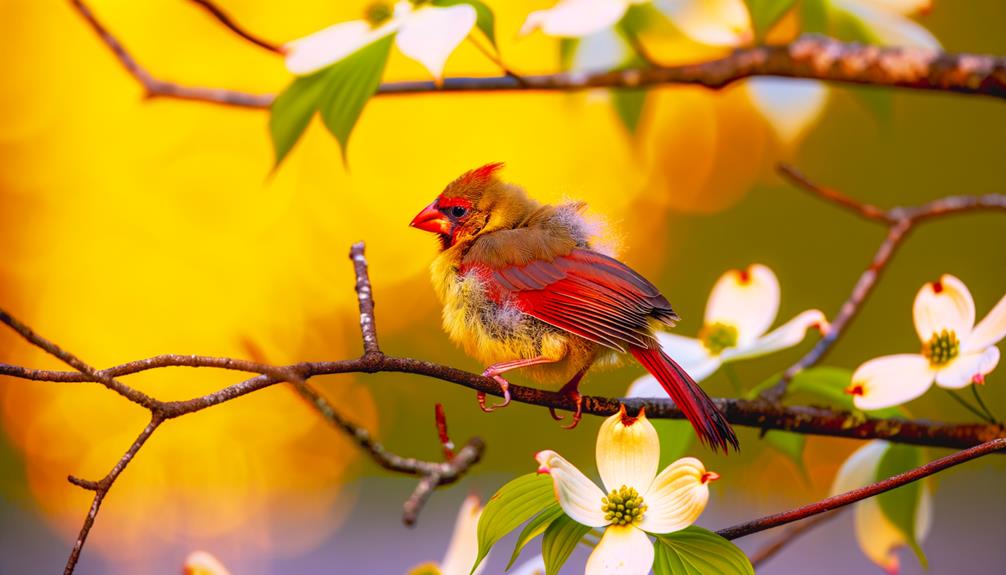Baby Cardinal: What Do You Do When You Find One?
To support a baby cardinal, recognize it exhibits altricial behavior, reliant on parents for warmth and nourishment. Parent cardinals feed them a protein-rich diet every 10-15 minutes to aid muscle development.
You'll observe nestlings producing begging calls and displaying a gaping reflex for feeding. As they mature, baby cardinals engage in wing-flapping exercises to strengthen flight muscles and explore their surroundings to build survival skills.
Parental defense strategies are essential to protect them from predators like snakes and hawks. As they grow, they progress from begging calls to foraging independently.
Understanding these stages is vital for their successful development.

Key Takeaways
- Ensure a safe and stable nest environment with proper thermoregulation for the eggs and nestlings.
- Feed the baby cardinals a protein and fat-rich diet every 10-15 minutes to support growth.
- Protect the nest from predators using alarm calls, decoy flights, and aggressive displays.
- Encourage wing flapping exercises to strengthen flight muscles and prepare for fledging.
- Support exploratory behaviors and foraging practice to help baby cardinals adapt to their surroundings.
Nesting and Hatching
In the early stages of a baby cardinal's life, the female cardinal carefully constructs a nest using twigs, grass, and other plant materials to ensure a stable and secure environment for the eggs. You'll notice her selecting materials with great care, ensuring the nest's structure is both strong and insulated.
This behavior is essential for thermoregulation, protecting the developing embryos from temperature fluctuations and predators. Scientific observations confirm that female cardinals often choose sites with dense foliage to obscure the nest from potential threats.
The clutch usually consists of three to four eggs, which she incubates for about 11 to 13 days. During this period, her dedication to maintaining ideal incubation conditions is crucial for successful hatching.
First Days in the Nest
The moment baby cardinals hatch, they exhibit altricial behaviors, remaining entirely dependent on their parents for warmth, nourishment, and protection. You'll notice their eyes are closed, and they lack feathers, making thermoregulation impossible without parental aid.
The nestlings produce begging calls, stimulating feeding and care behaviors in adult cardinals. They display a gaping reflex, opening their mouths widely when sensing movement or vibrations—a critical behavior for feeding.
During these initial days, the parent cardinals engage in brooding, covering the nestlings with their bodies to maintain ideal temperature. The nest structure, typically made of twigs and grasses, provides some insulation but is insufficient without parental involvement.
Observing these behaviors highlights the importance of parental investment in avian development.
Feeding and Nutrition
As the baby cardinals' initial days pass, their begging calls become more insistent, prompting the parents to deliver a steady diet rich in protein and fats, primarily consisting of insects and caterpillars. You'll observe that this diet is necessary for rapid growth and development.
The parents regurgitate partially digested food, guaranteeing the chicks can digest it easily. Research shows that high-protein diets contribute to muscle development, while fats are vital for energy. The feeding frequency is high, often every 10-15 minutes, to meet their metabolic needs.
As days progress, you might notice the inclusion of seeds, indicating a gradual dietary shift. This careful feeding strategy ensures that the chicks develop strong, healthy bodies capable of thriving in the wild.
Developing Flight Skills
You'll notice baby cardinals start flapping their wings vigorously while still in the nest, a crucial behavior for developing the muscle strength and coordination needed for their first flights. This flapping is known as 'wing exercise,' and it's necessary for building the pectoral muscles. Observing them, you'll see how these small but powerful movements gradually become more controlled. Studies show that this behavior significantly reduces the risk of fledging failure.
Here's a breakdown of their developing flight skills:
| Stage | Behavior | Purpose |
|---|---|---|
| Nestling | Wing Flapping | Muscle Development |
| Branchling | Short Hops | Balance and Coordination |
| Fledgling | Sustained Flight Attempts | Strengthening Flight Muscles |
These stages are crucial for ensuring their survival and successful independence from the nest.
Exploring Their Surroundings
Curiosity drives baby cardinals to venture beyond their nest, initiating a critical phase where they interact with and learn about their environment. You'll notice that they exhibit exploratory behaviors such as hopping between branches and pecking at various objects. These activities help develop their spatial awareness and motor skills.
According to ornithological studies, juveniles engage in foraging practices, identifying potential food sources like seeds and insects. This exploration is essential for honing their survival instincts and adapting to their habitat.
Observing their keen interest in different textures and surfaces reveals their innate drive to understand their surroundings. The process is systematic, as they build mental maps of their territory, essential for avoiding predators and finding resources.
Learning to Communicate
While baby cardinals explore their surroundings, they simultaneously start developing vocalizations to communicate with their parents and siblings.
You'll notice their calls, known as 'begging calls,' are high-pitched and repetitive, designed specifically to elicit feeding and care from adults.
As they mature, these vocalizations become more complex. They learn to distinguish between alarm calls and normal communication through auditory learning and mimicry.
Scientific studies have demonstrated that young cardinals are capable of recognizing and responding to their parents' unique calls within days of hatching.
This early development of communication is vital for their survival, enabling them to alert parents to their needs and potential threats.
Social Interactions
As baby cardinals grow, their social interactions become increasingly intricate, involving play behaviors, social bonding, and the establishment of hierarchies within their family groups.
You'll notice fledglings engage in mock fights, a form of play behavior that hones their motor skills and coordination.
Social bonding is vital; they preen each other's feathers, a behavior known as allopreening, which strengthens familial ties.
Hierarchies emerge as dominant and subordinate roles are established through subtle cues like beak pecking and vocalizations.
These interactions aren't random; they follow predictable patterns observed in avian social structures.
Predators and Safety
You'll notice that baby cardinals face threats from various predators, including snakes, hawks, and domestic cats, which greatly influence their survival strategies.
Observing their nesting behavior, you'll see they often choose dense foliage to enhance camouflage and reduce visibility.
Additionally, adult cardinals exhibit aggressive defense tactics, such as mobbing predators, to protect their vulnerable young.
Common Cardinal Predators
Cardinals face numerous threats from predators such as hawks, snakes, and domestic cats, each posing unique risks to their survival. Hawks, leveraging their sharp vision and swift flight, often target cardinals from above, executing rapid, precise attacks.
Snakes, particularly those skilled at climbing, can invade nests, preying on eggs and fledglings. Domestic cats, an invasive species, hunt cardinals on the ground, exploiting their stealth and agility. Research shows that these predators profoundly impact cardinal populations, stressing the importance of understanding their behaviors.
Studies indicate that habitat fragmentation exacerbates these threats by reducing available cover. By recognizing these predators and their hunting methods, you can better appreciate the survival challenges cardinals face in their natural habitat.
Nesting and Camouflage
In their quest for survival, these vibrant birds meticulously construct well-hidden nests, employing natural materials that blend seamlessly with their surroundings to evade predators.
You'll find that cardinals often choose dense shrubs or thickets, providing both physical cover and camouflage. They use twigs, leaves, and grasses, creating a compact structure that's difficult to spot. This strategic placement minimizes exposure to common predators like snakes, squirrels, and larger birds.
The nesting site's elevation and proximity to protective foliage further enhance safety. Studies show that nests with higher concealment rates have significantly lower predation risks.
Parental Defense Strategies
When facing threats from predators, male and female cardinals employ a series of coordinated defensive maneuvers to protect their nest and young. You'll observe their vigilance as they take turns guarding and foraging.
Their tactics include:
- Alarm Calls: High-pitched sounds to alert each other and confuse predators.
- Decoy Flights: Flying away from the nest to lure predators in the wrong direction.
- Aggressive Displays: Fluffing feathers and making sharp movements to appear larger and more threatening.
- Physical Attacks: Directly confronting smaller predators, using their beaks and wings.
These strategies are essential for ensuring the survival of their offspring, as cardinals face numerous predators like snakes, cats, and larger birds.
Seasonal Changes
Have you ever noticed how juvenile cardinals adapt their behaviors and plumage in response to seasonal changes?
During spring, their plumage is duller, providing camouflage amid blooming flora. This cryptic coloration helps them evade predators.
As summer transforms to fall, juveniles undergo molting, replacing feathers with brighter hues, signaling maturity. Behaviorally, they switch from frequent begging calls to more independent foraging.
Scientific observations show that these changes align with hormonal shifts triggered by photoperiod variations.
You'll also see them adjusting feeding habits, focusing on insects in summer and seeds in winter, reflecting resource availability. These adaptive strategies enhance their survival across seasons, demonstrating nature's intricate planning.
Understanding these patterns offers insight into the cardinal's lifecycle and ecological role.
Path to Independence
Juvenile cardinals, frequently observed during their fledgling stage, exhibit a series of behavioral and physiological alterations that mark their gradual path to independence. You'll notice their development as they:
- Strengthen flight muscles: Daily wing flapping and short flights enhance muscle coordination.
- Develop foraging skills: They begin to identify and consume a variety of seeds and insects.
- Establish territory: Young cardinals start to explore and claim their own space, a critical survival behavior.
- Reduce parental dependence: They gradually rely less on parental feeding and protection.
These changes are vital for their survival and successful progression to adulthood. Observational studies show that fledglings increase their self-sufficiency through practice and mimicry, ensuring they can thrive independently in their natural habitat.
Conclusion
Imagine you're a gardener nurturing a young sapling. Each leaf unfurls with care, much like a baby cardinal's journey. Your attentive watch guarantees it thrives, from fragile nestling to confident flier.
Just as the sapling bends with the wind but stands tall, the cardinal adapts to its environment. Predators lurk and seasons change, yet your vigilance and nature's design guide it toward independence.
In this grand ecosystem, your role blends observation with delicate intervention, securing survival and growth.






